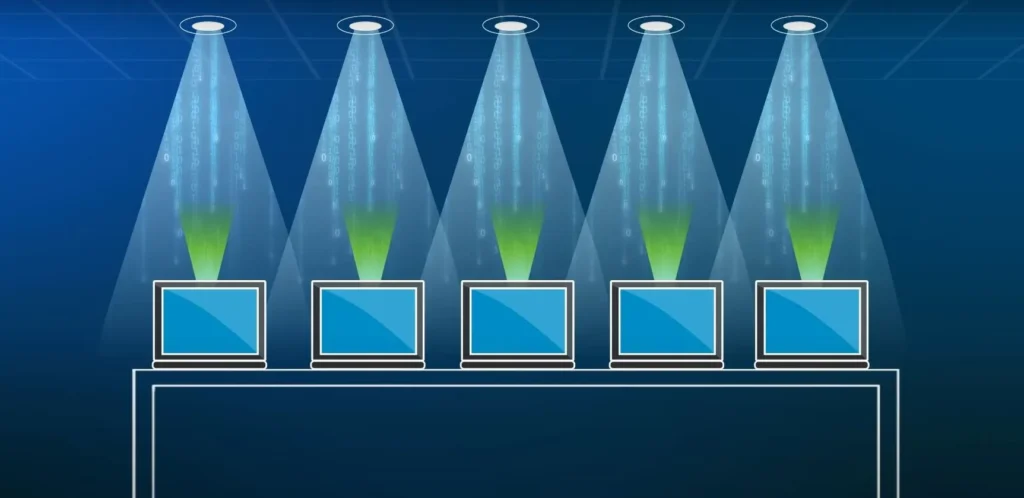Wi-Fi and other wireless networks, particularly the internet, are essential to modern life. But much faster data rates are promised by the new Li-Fi (Light Fidelity) technology, which presents intriguing prospects for wireless internet in the future. Let’s become acquainted with the fundamentals of Li-Fi technology, including its benefits and drawbacks.
Fiber optic and Li-Fi data transfer
Li-Fi is an optical data transmission technology that communicates via light. Li-Fi transmits data using light waves or infrared light, as opposed to Wi-Fi, which uses radio waves. Light-emitting diodes (LEDs), which are invisible to the human eye but can be detected and understood by specialized receivers, are rapidly turned on and off to enable this.
Lightwave Internet: Operational Concept

The basic idea behind how Li-Fi-based high-speed Internet works is very straightforward. Data is transmitted by modulating light from a source (like an LED), which is subsequently received and demodulated by a photo detector on the receiving end. After that, this data is transformed into a data stream so that a network-connected device can understand it. The procedure is completed at a breakneck pace, enabling the transfer of remarkable volumes of data.
Light guides and visible light technologies
One essential element of Li-Fi technology is visible light communication, or VLC. This technology enables the creation of a high bandwidth network using LED lights.
But how can light get from the source to the recipient, one wonders? Light guides, which are transparent structures used to guide light from one point to another, hold the key to the solution. Light guides are a crucial component of Li-Fi infrastructure and are already utilized in fiber optic communication.
The origins and development of Li-Fi
First stop on the journey: theoretical underpinnings
It has long been known that light waves can be used for wireless communication. As early as the 20th century, in fact, systems for communicating via visible or infrared light were developed. But in his well-known TED Talk, University of Edinburgh professor Harald Haas brought the term “Li-Fi” to the world in 2011.
In contrast to conventional Wi-Fi connections, Haas showed how light from a single LED bulb could provide faster and more secure internet. He founded a business named “pureLiFi” with his group to focus on developing Li-Fi technology and apparatus.
Advancement and fresh records
Since then, Li-Fi development has made numerous advancements. 2013 saw the demonstration of a 150 Mbps light link by a Chinese research team. PureLiFi’s first commercial product, the LiFi-X, a portable USB adapter for Li-Fi network connectivity, was released in 2015.
With a speed of 224 Gbps, researchers at University College London broke the previous record for Li-Fi in 2020. That can download eighteen 1.5GB movies in a single second!
The Li-Fi’s future
Li-Fi is still developing and being used in many aspects of our lives today. Li-Fi is already being used in pilot programs to provide public internet access in businesses, cities, and even in aircraft. Although there are certain infrastructure and technological obstacles, Li-Fi appears to have bright futures.
Li-Fi’s advantages over Wi-Fi
Li-Fi is superior to conventional Wi-Fi in a number of ways. Among the most crucial is the capacity to offer extremely high data rates. Li-Fi data rates are significantly faster than Wi-Fi’s maximum speed, with a maximum of 224 Gbps.
It’s also crucial to remember that Li-Fi can be utilized in places like hospitals and airplanes where using radio waves is either prohibited or impractical.
Constraints with Li-Fi technology
While Li-Fi offers many benefits, it is not without its drawbacks. Light waves are limited in certain situations by their inability to pass through walls and other obstructions. Also, in order to support this technology, new infrastructure will be needed. Li-Fi is a potentially ground-breaking technology that has the potential to transform wireless network usage. Therefore, keep in mind that the next time you turn on the lights, this small gesture could eventually provide you access to both lighting and the internet. One of the most significant technological advances in the upcoming years may be Li-Fi.